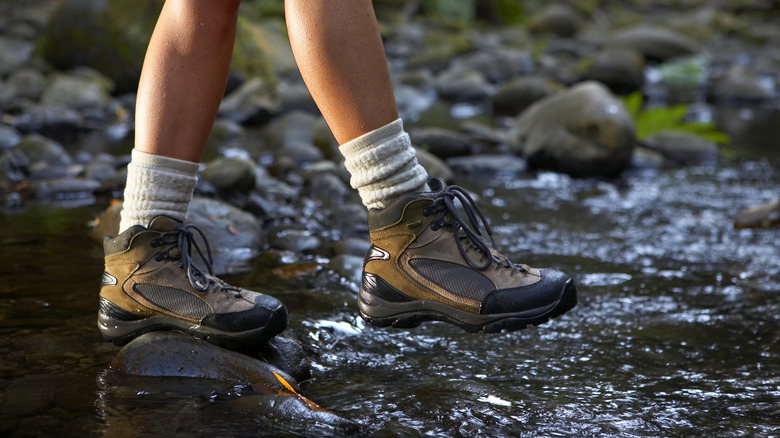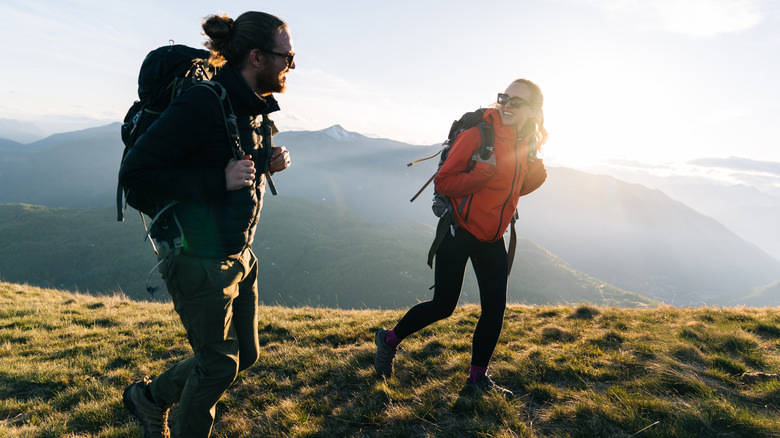What You Should Wear For A Springtime Hike
We may receive a commission on purchases made from links.
Springtime hiking requires adequate preparation. The weather can change quickly, from warm sunshine to unexpected rain or chilly winds. Your outfit must adapt to these shifts while keeping you comfortable throughout your hike. The key lies in layering. Start with a lightweight, moisture-wicking base layer to keep sweat off your skin. This layer is essential for regulating your body temperature during physical activity. On top of that, add a breathable, insulating mid-layer like a fleece or light sweater for warmth. Finish with a waterproof and wind-resistant outer layer to protect against rain and cool breezes.
Of course, you can't forget your bottoms. Choose quick-drying, stretchy hiking pants that provide mobility and comfort. These pants should protect you from brush or mud without being too heavy. For your feet, pick durable, moisture-wicking socks made of wool or synthetic blends to avoid blisters and keep your feet dry. Selecting the right footwear — preferably lightweight hiking boots or trail shoes with good grip — is crucial to navigating varied terrain safely.
Finally, accessories can make or break your comfort level. Bring a wide-brimmed hat or cap to shield your face from the sun, and don't forget a lightweight pair of gloves for early-morning or late-afternoon chills. A small, packable rain poncho is also a smart addition. With the broad strokes covered, let's get into the nitty-gritty.
Footwear is your foundation for the trail
Spring trails can be slick with mud or damp from melting snow, so sturdy, supportive footwear is non-negotiable. You should know how to select the best boots for a wet hike. Waterproof hiking boots with strong traction are your best bet for navigating wet, uneven terrain. Look for boots that provide good ankle support to help prevent injuries like sprains. If the trail is relatively flat or short, trail shoes can offer a lighter alternative, but always prioritize grip and durability.
Make sure to break in new boots or shoes before your hike. Wearing them around town or on short walks can prevent blisters when you're miles from the trailhead. Along with quality footwear, bring high-performance socks designed for hiking. Look for pairs with cushioning and moisture-wicking properties to keep your feet comfortable, like the merino wool hiking socks by Danish Endurance. Mud, water, and debris are common obstacles on spring trails. Gaiters, such as the Frelaxy Leg Gaiters, are an excellent addition for protecting your boots and socks from these elements. They're especially useful if your route includes stream crossings or muddy sections.
Pack light but smart when it comes to foot care. A mini first-aid kit with blister pads, extra socks, and anti-chafing balm can save your hike if discomfort arises. Finally, avoid the common packing mistake of overloading your bag; an unbalanced pack puts unnecessary strain on your feet and makes navigating the trail harder. Prioritizing your footwear ensures every step feels supported and secure.
Choosing the perfect backpack for your hike
Your backpack is more than a storage tool — it's a crucial part of your hiking outfit. For spring hikes, aim for a lightweight, well-fitted pack that can carry essentials without weighing you down. Look for adjustable straps and padding that distribute the load evenly across your shoulders and back. A poorly balanced or overfilled bag can cause fatigue and strain, so pack only what you truly need.
Spring hikes often require gear for changing conditions. A pack with multiple compartments can help you organize items like extra layers, rain gear, and snacks. Make sure your bag has a hydration system or room for water bottles to keep you hydrated. The Tactical Hydration Backpack by THYWD is an excellent choice. Many spring trails lack clean water sources, so bringing enough water is essential. Waterproofing is vital in spring, as sudden showers are common. A pack with water-resistant material or a rain cover will keep your gear dry. For longer hikes, look for additional features like external loops for trekking poles or a separate pocket for wet items.
Packing smart means including the right clothing layers, first-aid essentials, navigation tools, and a small repair kit. Even if your hike is short, these items can make a difference if conditions change. By investing in a quality backpack and planning its contents, you'll ensure a comfortable, safe hiking experience.
Managing layers for maximum comfort
Layering isn't just about choosing the right pieces — it's about knowing when and how to adjust them during your hike. Spring weather can fluctuate wildly, so staying comfortable requires attention to your body and the environment. Start your hike with all layers on if it's cool, but be ready to shed the mid-layer or outer shell as you warm up. Stashing these layers in your backpack keeps you from overheating while climbing. When the temperature drops again or the wind picks up, quickly adding back a layer keeps you warm.
Moisture management is also essential. Sweat can leave you chilled if it soaks your base layer, so remove layers early to avoid overheating. Carrying a spare base layer to change into during breaks can help you stay dry and warm. A windproof and waterproof shell is your most versatile layer. Even if the day begins sunny, unexpected rain or a cool breeze can make it indispensable. Ventilated options with pit zips or mesh panels, like FREE SOLDIER's Men's Outdoor Waterproof Soft Shell, allow you to regulate heat without fully removing your jacket. Effective layering keeps you comfortable and prevents energy loss, letting you enjoy your spring hike to the fullest.
Why accessories matter more than you think
Accessories might seem secondary, but they can make or break your springtime hike. Sunglasses with UV protection shield your eyes from the sun's glare, especially when hiking in open areas or near water. A wide-brimmed hat protects your face from harmful rays while keeping you cool, making it an essential, too.
Don't overlook gloves, even in spring. Lightweight gloves provide warmth for early-morning starts or unexpected dips in temperature. A buff or neck gaiter is another versatile accessory — it can protect you from wind, sun, or even bugs. Spring often brings rain, so pack a compact, waterproof poncho or rain jacket, just in case. For hydration, consider a reusable water bottle with an insulated design to keep water cool. Make sure you have about one litre of water for every five miles of terrain you cover.
Navigational tools are also critical accessories, even if you've planned your hiking route carefully. A map, compass, or GPS device helps ensure you stay on track. Don't rely solely on your phone, as signal loss or battery drain can leave you stranded. Other useful items include trekking poles for stability on slippery trails and a headlamp in case your hike lasts longer than planned. Accessories might seem like extras, but the right ones enhance comfort and safety. When you bring the right seasonal gear, you can handle whatever the trail throws your way.




